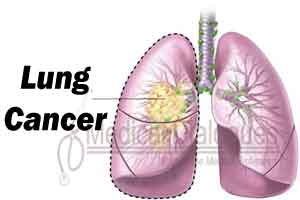- Home
- Editorial
- News
- Practice Guidelines
- Anesthesiology Guidelines
- Cancer Guidelines
- Cardiac Sciences Guidelines
- Critical Care Guidelines
- Dentistry Guidelines
- Dermatology Guidelines
- Diabetes and Endo Guidelines
- Diagnostics Guidelines
- ENT Guidelines
- Featured Practice Guidelines
- Gastroenterology Guidelines
- Geriatrics Guidelines
- Medicine Guidelines
- Nephrology Guidelines
- Neurosciences Guidelines
- Obs and Gynae Guidelines
- Ophthalmology Guidelines
- Orthopaedics Guidelines
- Paediatrics Guidelines
- Psychiatry Guidelines
- Pulmonology Guidelines
- Radiology Guidelines
- Surgery Guidelines
- Urology Guidelines
Fullerene compounds can effectively kill lung cancer cells, find researchers

Lung cancer is one of the most frequently experienced and severe forms of cancer. Every year more than a million of new cases are reported all over the world and 60% of them are fatal. The existing chemotherapeutic drugs, cytostatic agents, suppress cancer cells development causing them to die, but at the same time, they are highly toxic for healthy cells which can lead to serious side effects
Researchers have discovered that fullerene compounds have anticancer effects and can effectively kill non-small-cell lung carcinoma cells and found out the mechanisms behind their anti-tumour activity.The study has been published in the Journal of Medicinal Chemistry.
A fullerene is a special form of carbon with molecules consisting of 60 carbon atoms, which look like a soccer ball. To make fullerenes soluble in water and biological media, polar functional groups are chemically attached to their surfaces.
About 85% of all lung cancer cases are non-small-cell lung carcinoma cases. This tumour type is difficult to treat because of the aggressive metastatic disease (spreading into other organs and tissues), frequent relapses (recurrence of the disease) and resistance to the standard anti-tumor drugs.
A group of scientists from Skoltech headed by Professor P. A. Troshin in collaboration with a team from National Taiwan University have found out that some of the fullerene compounds are toxic for non-small cell lung carcinoma cells and cause their death. At the same time, they are practically non-toxic for healthy cells which was shown both in cell models and in animal studies.
"The mechanisms leading to cancer cells death under the influence of fullerene derivatives have been unknown until recently. Our Taiwanese colleagues, while studying our compounds, succeeded in discovering that at least two mechanisms are involved: apoptosis and autophagy. It is interesting to know that it is the nature of the polar groups attached to the fullerene molecule that launches one or other mechanism in each particular case," says Olga Kraevaya, Skoltech PG student, co-author.
The anti-tumor activity of the fullerene derivatives has a great potential for the development of new effective medicinal products for the treatment of non-small-cell lung carcinoma.
For more details click on the link: http://dx.

Disclaimer: This site is primarily intended for healthcare professionals. Any content/information on this website does not replace the advice of medical and/or health professionals and should not be construed as medical/diagnostic advice/endorsement or prescription. Use of this site is subject to our terms of use, privacy policy, advertisement policy. © 2020 Minerva Medical Treatment Pvt Ltd